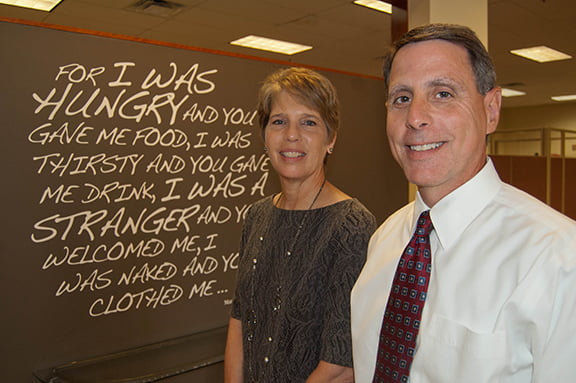
After seven years at the helm of Catholic Charities of Northeast Kansas, Jan Lewis has been succeeded by Ken Williams, who formerly held executive positions at Black & Veatch and World Vision International. He plans to build on Lewis’ efforts to reconnect Catholic Charities with the average Catholic in the pew. Photo by Joe Bollig.
My first eight weeks with Catholic Charities of Northeast Kansas have been eye-opening.
by Ken Williams
My first eight weeks with Catholic Charities of Northeast Kansas have been eye-opening.
From the outside looking in, it is impossible to see the breadth of services that our staff and volunteers provide. It is hard to see the challenges that they face each day to make limited resources stretch to meet the ever- growing needs of the people who seek our help. But it is especially hard to really see the faces of those we serve.
I want you to stop reading for 30 seconds, close your eyes and then imagine what you think a typical person on “food stamps” would look like. . . . How old are they, what is their ethnic and educational background, where do they live? Now, open your eyes.
Did you picture a family with children under 18 with one or both parents working? Did you imagine that the color of their skin was white or that they were a retired couple living on a fixed income? Did you think of someone who is in a wheelchair or suffering from congestive heart failure?
According to the U.S. Department of Agriculture, 98,344 Kansas households — 298,642 individuals — received SNAP (Supplemental Nutrition Assistance Program) benefits in fiscal year 2011. Within those households, 20 percent had a person 60 years of age or older residing. Over 55 percent of the households had children under 18 years of age in the home.
The majority (65 percent) of the households reported their ethnicity as “white” and a whopping 83 percent had one or more people in the workforce within the past 12 months.
These nearly 100,000 households are not “the poor” — they are our neighbors. Their children go to our schools; they worship alongside of us in our churches. They cherish the same hopes and dreams that we do — a happy home, healthy food on the table, a good education and better life for their children.
And yet, in the “heart” of America, we are still quick to judge. We get swept up in the uncivil discourse of our times, focusing on our differences and drawing lines in the sand, rather than opening our eyes to see the face of God in those around us.
On Sept. 28, the House of Representatives voted to cut $40 billion from the Supplemental Nutrition Assistance Program. While it is important as a nation to be fiscally responsible, the vast majority of this cut will be absorbed by our children and our seniors.
In his message to David Cameron, British prime minister, for the G8 meeting in June, Pope Francis challenged the gathered nations by saying that “the goal of economics and politics is to serve humanity, beginning with the poorest and most vulnerable wherever they may be.”
How well are we doing against that goal?




